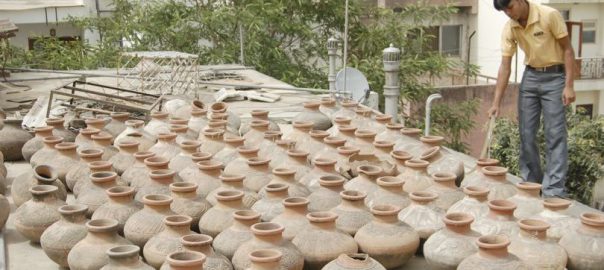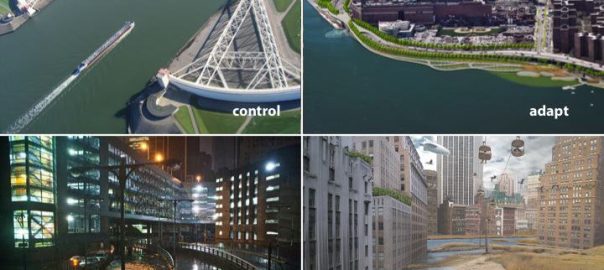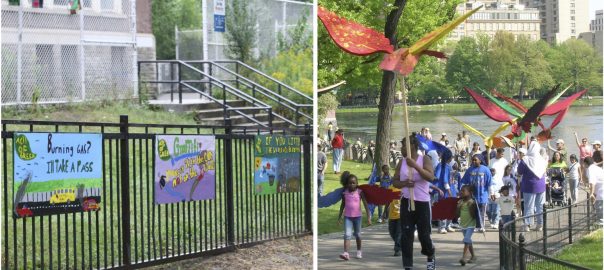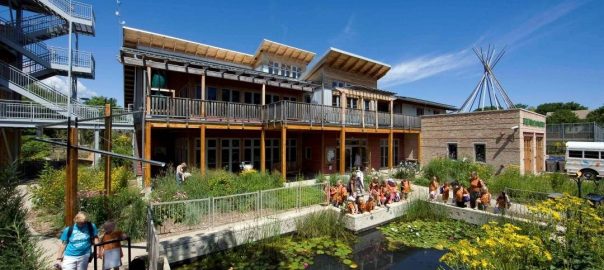I recently relocated to New Delhi after more than a decade — a set of years which entailed rapid economic growth for India. Infrastructure development in cities around the country is booming and it is difficult to travel for too long without meeting the rising towers of concrete and shining glass. Urban population, too, is growing at an unprecedented rate and in these next few decades one of the most massive shifts to urbanization in world history will unfold in India. This urban sprawl creates unique challenges related to land-use planning, ecological structure, pollution, biodiversity, energy demand and cost, heat health stress, and flows of water, nutrient and energy within cities and their surrounding areas. As Indian cities continue to grow in population and area, the magnitude and potential consequences of negative effects on temperature, humidity, cloudiness, precipitation and atmospheric flow patterns are expected to increase.
Ensuring both development and sustainability for India’s cities thus results in a series of interrelated issues concerning clean air, water, waste, food, biodiversity, and energy use — all in the context of rapid urbanization and with the challenges of governance and weak institutional capacity. Cities across the country need to develop policies that strive to balance the competing priorities of substantially expanding while minimizing detrimental environmental and climate change effects.
Amongst the different tradeoffs that Indian cities have to make to be livable and resilient, one significant opportunity stands out: energy efficiency in buildings. Buildings already play a key role in the country’s energy use, currently accounting for more than 30 percent of electricity consumption. Yet, two-thirds of commercial and high-rise buildings that will exist by 2030 are yet to be built. India’s building-occupied area is projected to skyrocket from 8 billion square meters in 2005 to 41 billion in 2030 — a staggering statistic. Analyses of this sector show that India could save $42 billion each year simply by improving energy efficiency in buildings. Further, the need for almost 3,000 MW of generation capacity could be avoided in an already severely electricity-constrained climate. All these factors makes energy efficiency — which is often referred to as an “invisible resource” — the cheapest, fastest and cleanest way to improve the sustainability of cities. The unique crossroads that Indian cities currently find themselves in, where the bulk of building and infrastructure development is yet to occur, means that energy efficiency is a singular opportunity to protect the environment and lock down energy and cost savings.
Recognizing these tremendous benefits of energy efficiency, students at the National Institute of Design in Bangalore created this creative animation, which makes energy efficiency, our collective invisible resource, visible!
Within energy efficiency options, roofs can play an important role in benefiting a building. Roofs can represent up to 32 percent of the horizontal surface of built-up areas and are important determinants of the urban environment. As protected and secure spaces, rooftops have many advantages as a site for urban vegetation — though at present they are largely blighted spaces. Roofs also play an important role in providing passive cooling to the buildings they cover. When constructed correctly, roofs can reduce the urban heat island effect that cities face, which is the result of the densely built urban centers experiencing hotter temperatures than the rural surroundings. Urban heat islands lead to higher energy consumption within cities to keep building inhabitants cool in the summer. Heat islands are also associated with negative health impacts such as increasing mortality rates and hospital asthma admissions.
Within the Indian building sector, commercial and residential buildings in urban areas account for most of the total consumption of electricity. This occurs through a building’s mechanical systems and equipment, including heating, ventilating, and air-conditioning, hot water heating, interior and exterior lighting, electrical power and appliances. Commercial buildings such as new office spaces, IT offices and parks, data centers, hospitals, hotels, retail malls and high rise residential buildings are all becoming more energy-intensive. The rate of increase in commercial electricity consumption is also much more rapid than the annual rate of increase in the floor area of commercial buildings. Unfortunately though, at present most of the modern Indian buildings use more than twice the amount of energy compared with their international counterparts. While many of these new structures can match international standards of appearance with their shining glass surfaces, few of them are designed in a way that pays attention to how these modern buildings actually use and manage their energy.
There are a few champions within the building sector who recognize the many benefits of designing and operating a world-class energy efficient structure — with the positives ranging from:
- Cost and energy savings from lower energy bills.
- Increased demand by tenants that recognize the cost savings, energy reduction, and higher employee productivity enabled by energy efficiency.
- Health benefits from well-designed efficient buildings such as better indoor air quality and a healthier environment leading to higher employee productivity and retention.
Energy savings also lower greenhouse gas emissions, thus effectively addressing climate change and its accompanying hazards. There is a growing awareness in Indian cities about these many benefits, and while slow, the number of green buildings — or sustainable buildings, which are designed to be environmentally responsible and resource efficient throughout a building’s life cycle from siting to design, construction, operation, maintenance, renovation, and deconstruction — is increasing every year. Leadership in Energy and Environmental Design or LEED as it is often referred to, is a rating system for such green buildings. India now has 2,362 LEED registered buildings and 447 LEED rated buildings, with a total of 1.813 billion square feet of green building footprint. The country is said to rank amongst the top five countries in the world for area under green building cover, pointing to the increasing trend towards green and energy efficient spaces over the last ten years.
Some examples of green champions in the building sector from around the National Capital Region of Delhi are:
- ITC Green Center — With an area of 170,000 sq feet, the Center is the world’s largest zero percent water discharge, noncommercial green building, and compared to similar sized buildings it has a 30 percent smaller carbon footprint. The Center incorporates innovative design, water efficiency, indoor environmental air quality, materials and resource efficiency, a sustainable site, and an ecological commitment to its surroundings. It received a LEED Platinum award in 2004, the highest category of LEED ratings.
- AECOM (previously Spectral Services) Noida Headquarters — The building has green solutions like an efficient water cooled heating and ventilation system, reuse of treated sewage water for landscaping and the cooling tower, automated lighting systems, a simulated roof skylight designed for optimal day lighting, thermal insulations, solar heaters, and highly reflective roof surfaces. It received a LEED Platinum award in 2007, and was amongst the first buildings not just in India but in the world to receive this rating.
- Bayer’s Eco-Commercial Building — The eco-commercial building in Greater Noida is Bayer’s first emissions-neutral office building in Asia. It entails various energy conservation measures such as thermal insulation for roofs, lighting controls, efficient central chillers and efficient windows. The roof is fitted with photo-voltaic solar cells. Bayer eco-commercial building received a LEED Platinum award in 2012 and at the time achieved the world’s highest LEED score to date.
Other rating systems that India uses are the Green Rating for Integrated Habitat Assessment or GRIHA and the Bureau of Energy Efficiency’s Buildings Star Rating Program. While rating systems are important in motivating the higher-end of real estate developers, baseline energy efficiency can be established in buildings with the use of energy codes and policies. India has a voluntary Energy Conservation Building Code, which prescribes a minimum standard for energy use in new buildings and major retrofits. The code applies to buildings with a connected load of 100 kW or 120 kVA, which is approximately equivalent to a five stories or higher commercial or high-rise residential building. While each of these initiatives is a step in the right direction, the progress to date remains a small fraction of the overall growth and potential in the building market.
I’d like to focus now on a particular aspect of building energy efficiency that can have significant relevance for urban energy savings and biodiversity: the collective benefits of rooftops. A roof’s reflectivity is a key determinant of the surface temperature that the roof reaches and of how much heat gets passed through to the living space in the building interior. For the same amount of sunlight hitting a roof surface, a black roof can reach a high temperature of 80 degrees C (170 degrees F), and reflects only 5 percent of the incoming sunlight. A white roof, on the other hand, can reflect 80 percent of the incoming sunlight and reaches a much lower temperature of 44 degrees C (111 degrees F). The temperature of the roof can have dramatic influence over the interior living conditions of a building, particularly of the topmost floor. Modifying roof properties to make “cool roofs” — such as increasing reflectivity — can lower roof surface temperatures and thus represents a hugely beneficial opportunity for the mitigation of heat islands in cities and consequential negative health and energy impacts. Delhi’s governing bodies are in the process of promoting cool roofs, starting with installing such cool roofs on Delhi government buildings.
Another option for increasing the passive cooling techniques of roofs is the implementation of green roofs. Having plants, shrubs or grass correctly planted on roof surfaces provides thermal insulation to the building interior, increases the roof’s reflectivity, and increases cooling of the roof surface because of the evaporation of water from the vegetation’s soil (known as “evaporative cooling”). Green roofs are characterized into two general types, intensive and extensive, differentiated mainly by cost, depth of growing medium and choice of plants. Benefits of green roofs cover a large spectrum, including: preventing storm water runoff, creating an urban wildlife habitat, improved health from visual contact with vegetation, increased employee satisfaction, reduced stress, increased community space and overall improved livability of cities. These are in addition to energy and cost savings and reduced greenhouse gas emissions. In spite of these many benefits though, green roofs are yet to find widespread implementation in Indian cities, and a few successful pilot projects may help jumpstart this trend.
An alternative traditional solution for passive cooling which is used at times, and which utilizes the same principal of evaporative cooling, is to place clay pots filled with water on the building roof so that the day’s heat is used to evaporate this water instead of heating roofs and building interiors.

As Indian cities move into an unprecedented phase of growth and increasing accompanying stresses, cities will require livability and resilience to be built into their development plans. This will require alternative sources and spare capacity, contingency plans and the ability to recognize and react to new challenges and opportunities with innovative solutions. Identifying easy, quick and cheap solutions is a key part of this process, and given the staggering growth of India’s building occupied area — which is projected to skyrocket from 8 billion square meters in 2005 to 41 billion in 2030 — implies that incorporating building energy efficiency can help create new paradigms of urban development for cities across the country.
Radhika Khosla
New Delhi












Radhika
Great article!! just noticed it on the web.
Best..
Viney
The variety of the roofs varies with the shape and size of the building as the various Efficient Roofs are introduced for Efficient Buildings. In most of the cities in India the roofs are constructed in a way that it take good care of the temperature around as some of the cities are too cold or too hot to be in. The above post also gives a very informative knowledge about the various reliable roofs in India, One must go through the same.